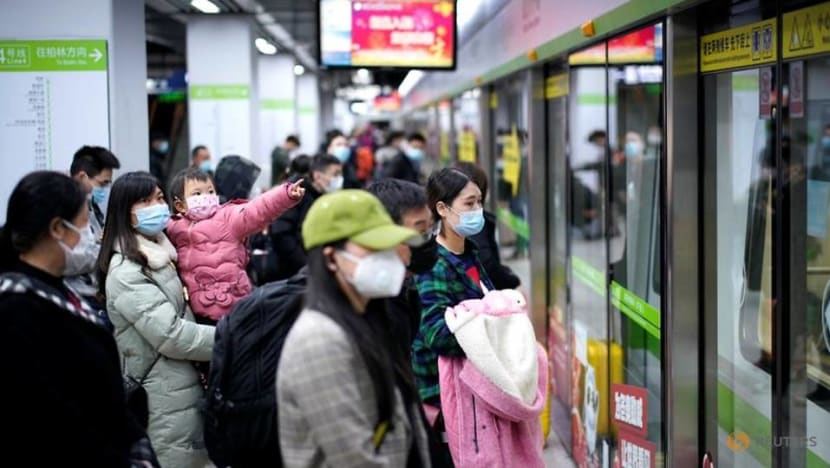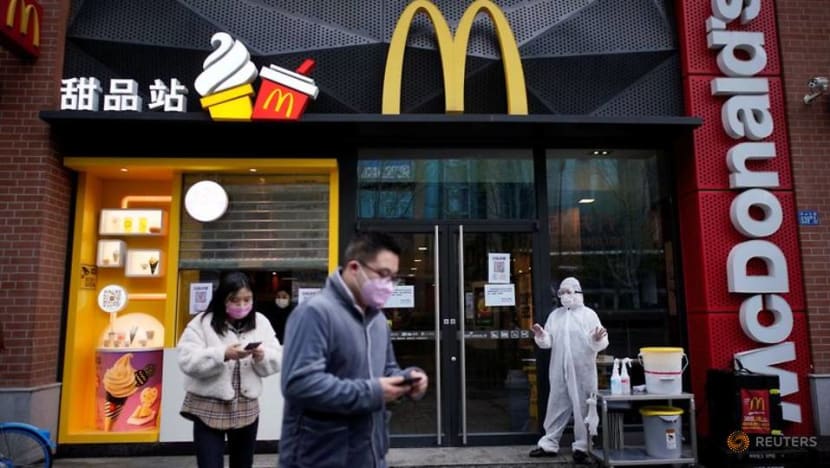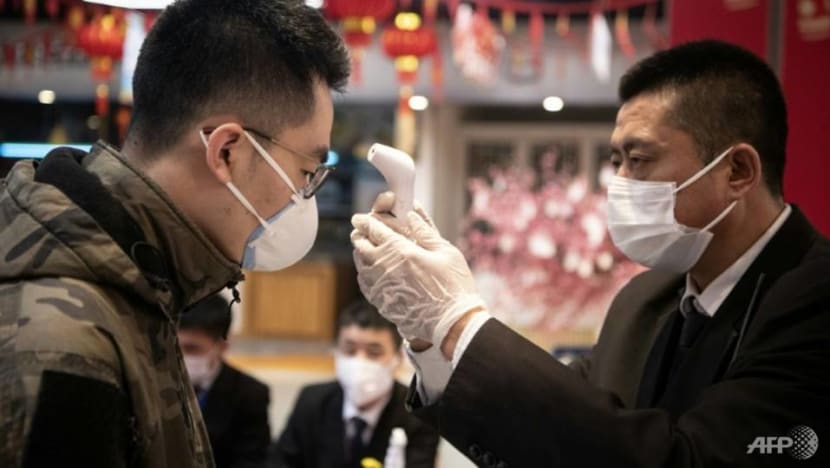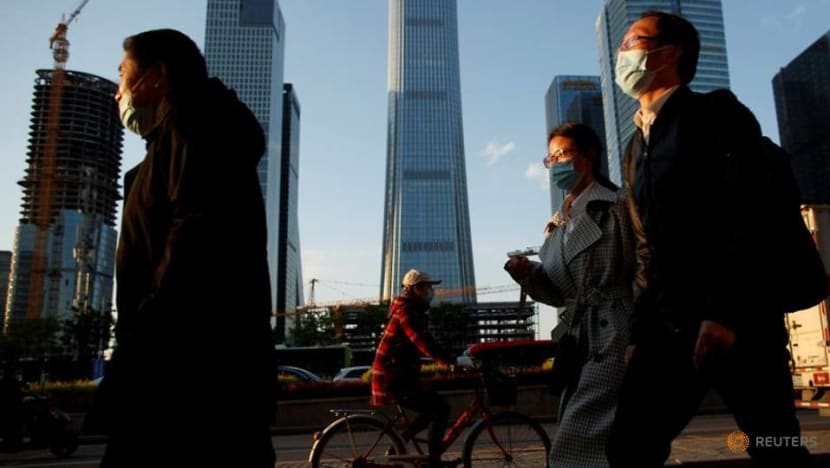commentary Commentary
Commentary: Life in China after COVID-19 lockdown gives normal new meaning
China has reopened parts of the economy for business while taking extra precautions, boosted consumer spending and is repairing its international standing, says Andre Wheeler.

People wearing face masks wait for a subway train in Wuhan of Hubei province, the epicentre of China's coronavirus outbreak, Mar 28, 2020. (Photo: Reuters/Aly Song)
SINGAPORE: After months of lockdown and the collapse of business activity, China is shifting gears to get back to “normal”.
The first steps have seen the easing of city and regional lockdowns. The gradual easing of restrictions since end-March culminated in the lifting of the over 70-day long lockdown on Wuhan on Apr 8, once ground-zero for the deadly epidemic.
In part, the easing was a response to the vast improvement in the situation and the recognition that most infections may come from importation, which border controls can keep a lid on now that community spread has been flattened.
The impetus may also be economic rather than epidemiological where China posted negative first quarter GDP figures, the first in almost 30 years.
Primed to restart its economy while taking great care to ensure the virus doesn’t trigger a second major outbreak, China has embarked on a three-pronged intervention, namely: Cautiously lifting lockdowns while controlling the risks of spread, stimulating the economy, and engaging in soft power diplomacy to repair its reputation.
READ: Commentary: How Wuhan mobilised to survive an over-70 day COVID-19 lockdown - and bounced back
READ: Commentary: How China ensured no one went hungry during coronavirus lockdown
CAUTIOUS LIFTING OF LOCKDOWNS, CONTROLLING RISKS OF SPREAD
With China recording more “imported” infection cases than local transmission, the central government is careful to balance creeping societal stress with that of reducing the risks of a second wave of widespread infections.
In Wuhan, citizens are now free to exercise, visit restaurants and coffee shops, but this reality is only possible because of strict compliance with social distancing rules and the mandated wearing of face masks under pain of enforcement and amid public fears of what the city had to endure.
Restaurants and public places must take the temperature of all entering their premises and refuse entry to those with a temperature in excess of 37 degrees Celsius.
LISTEN: How many stars will you give Singapore's F&B industry this COVID-19 season?

People must show a colour-coded verification of their health status, based on questions on their movement history and health declaration on Alipay and WeChat to gain entry into facilities including subways after scanning a QR code.
Residential committees also keep watch over households. Such efforts undergird hope the return to normalcy can be sustained by control measures and heightened vigilance.
Over and above these common practices, cities of strategic importance have new entry requirements, with the capital Beijing having some of the strictest. International flights have been redirected to one of 12 other cities where travellers comply with quarantine procedures that take 14 days, before they can enter Beijing city limits.
READ: Commentary: Think flying is dead? Four reasons why business travel will bounce back from the COVID-19 slump
STIMULATING THE ECONOMY
China had earlier announced in end-March a stimulus package, aimed at issuing special bonds and relaxing lending to boost the economy, with President Xi Jinping indicating the fiscal deficit ratio could rise to 3 per cent of GDP. A total of US$344.1 billion has been committed.
Local authorities have been enlisted in thinking of novel ways to spur growth, which have given birth to interesting approaches, such as the introduction of digital gift coupons to support personal consumption in catering, food delivery and online shopping.
Such a move may have been premised on China’s traditionally high savings rate at 45 per cent of GDP, which would lead cash assistance to remain in bank accounts. The Chinese central bank estimates the multiplier effect of digital coupons would be twice as much compared to cash.
READ: Commentary: COVID-19 is just a bump in the road of China’s long-term development
Moreover, consumer consumption made up more than half of China’s 2019 GDP growth in 2019, according to the National Development and Reform Commission.
Thirty provinces and cities have already introduced these, with Hangzhou having already issued US$237 billion in digital coupons, supporting also the burgeoning e-commerce sector, a vital lifeline for millions of entrepreneurs, merchants and manufacturers and home to some of China’s Big Tech giants.
READ: Commentary: In the time of COVID-19, China is revolutionising deliveries and e-commerce

China is also taking this rare opportunity to review regulations that stymie domestic investment. Interest rates have been eased by the People’s Bank of China on Monday (Apr 20), the second time this year.
Chinese financial institutions also rolled out support measures for small and medium-sized enterprises (SMEs), including increasing debt rollovers and providing specific credit lines for the resumption of production.
The country has also embraced a concerted effort to encourage inward foreign investment. This includes the liberalisation of investment banking and money management markets.
For the first time, beginning Apr 1, wealth funds can apply for licenses for wholly owned mutual fund management firms without the need for joint ventures.
China is keen to signal it is open for business, aided in part by a surprising announcement of the signing of 152 major industrial projects in Shanghai on Mar 31, with a value of US$62.3 billion that included foreign investor like Bosch, Mitsubishi and Walmart subsidiary Sam’s Club.
READ: Commentary: China billionaires a force to be reckoned with in global COVID-19 fight - and more
READ: Commentary: Why Singapore was among the world’s largest recipients of investments in 2019
SOFT POWER DIPLOMACY TO REPAIR REPUTATION
China’s economic recovery will largely hinge on whether the country can arrest the reputational damage caused by the pandemic, after much finger-pointing, concerns over transparency and conspiracy theories suggesting the virus was manufactured in a Wuhan lab have grown.
In total, China has dispatched 300 doctors, millions of coronavirus testing kits and thousands of ventilators to Italy, with 1.8 million masks, 210,000 test kits, 36,000 protective suits, ventilators and thermometers delivered to Afghanistan, Bangladesh, Cambodia, Laos, Maldives, Mongolia, Myanmar, Nepal, Pakistan and Sri Lanka.
Apart from immediate actions to provide medical aid to affected countries, China is also reviewing the knock-on effects of the outbreak on its flagship Belt and Road projects.
BRI projects have been delayed in countries including Bangladesh, Cambodia, Kenya, Laos, Malaysia, Myanmar, Saudi Arabia and Sri Lanka, as Chinese workers who returned for the Lunar New Year found themselves trapped under lockdown.

READ: Commentary: Imagine a North Korea without Kim Jong Un. Here’s why you can’t
With the US’s announcement it would cease funding to the World Health Organisation, however, there is a chance for China to step up leadership in this area. After all, it has a Health Silk Road mechanism, a key component of the BRI, which seeks to build public health cooperation among BRI nations.
While much suspicions have surrounded China’s intention and the viability of the Health Silk Road in supplanting WHO, China has made no such grandiose claims of the Health Silk Road’s global pre-eminence.
It has instead positioned efforts under that ambit as aiding member states in receiving urgently needed medical supplies and the sharing of experience in epidemic control to build national capacities.
China will probably continue to push the Health Silk Road particularly through highlighting the importance of the BRI infrastructure network in delivering humanitarian aid amid border closures.
READ: Commentary: China's COVID-19 push for global influence
READ: Commentary: China makes inroads into Europe. That's creating some discomfort
This is no better demonstrated by the supply of medical equipment to Spain. Medical supplies were shipped out from Yiwu to Madrid using rail freight through the Alataw Pass in Xinjiang, a rail hub-and-spoke centre, managed by China Railway Express. About 70 per cent of Central Asia freight volume travels through the pass.
Aid can reach Madrid in just two weeks instead of the 50 days it normally takes.
The recent Wuhan-to-Duisburg rail shipment, being the first rail shipment out of the city, is notable. Medical supplies occupied 19 of the 50 containers, with the balance being auto-parts, electronics and optical fibres from the Chinese megacity that is also the global leader in producing personal protective equipment.
THE ROAD TO RECOVERY
Where a vaccine will not be forthcoming until 2021, China has made commendable strides in finding a path back to normalcy.

It might not be business as usual as the country grapples with the virus’ implications for its international standing.
But the steps it has taken to help restore some level of business activity and stimulate the economy in new ways while keeping a second wave of outbreaks in check is worth studying, especially for countries thinking of lifting lockdowns.
READ: Commentary: COVID-19 vaccine – why is it taking so long to develop one?
BOOKMARK THIS: Our comprehensive coverage of the coronavirus outbreak and its developments
Download our app or subscribe to our Telegram channel for the latest updates on the coronavirus outbreak: https://cna.asia/telegram
Andre Wheeler is chief executive of Asia Pacific Connex and has 20 years of international business experience in the US and Asia-Pacific.














